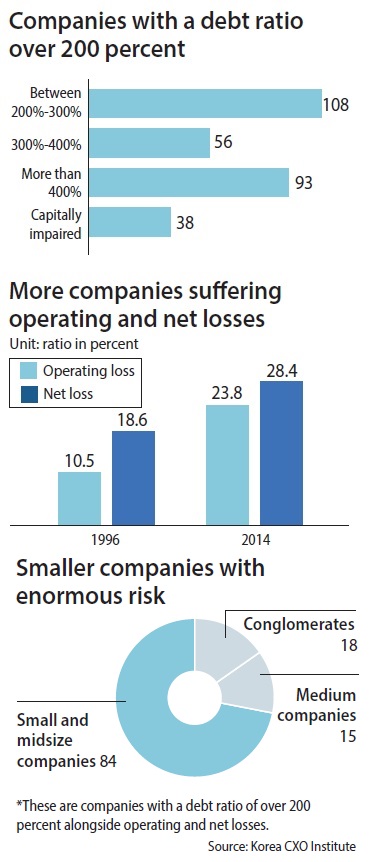Six percent of Korean firms face insolvency

According to a report by private corporate analysis agency Korea CXO Institute, 117 of Korea’s 2,000 companies, excluding financial firms, have debt-to-asset ratios of over 200 percent and are also suffering from operating and net losses as of last year.
The combined operating losses of the 117 companies amounted to 3.48 trillion won ($2.98 billion), while net losses totaled 8.3 trillion won.
The ratio of poor performers has grown significantly compared to 1996, the year before Korea faced its first financial crisis that bankrupted many companies, including conglomerates like Daewoo Group.
The report said 295 companies, or 14.8 percent, have a debt ratio of over 200 percent, but not all are recording operating or net losses.
For manufacturing companies, a 200 percent debt ratio is generally considered the most their balance sheets can handle before becoming insolvent.
Among the 295 companies, 108 were considered to be verging on insolvency. The remaining 187 were considered highly risky.
There were 56 companies with debt ratios of 300 percent, at which financial costs begin to eat into profits.
Ninety-three companies had debt ratios at 400 percent, meaning they faced the risk of shutting down.
At the bottom of the list were 38 companies with deficits so huge that they couldn’t mend their losses even if they used every penny earned.
The total debt of the 295 companies amounted to 270 trillion won, while total capital was only 70 trillion won. The average debt ratio stood at 384 percent.
There are an increasing number of small and midsize companies in trouble.
Among the 117 companies with debt ratios over 200 percent alongside operating and net losses, the most were smaller businesses with revenues of less than 100 billion won, at 84.
Eighteen were conglomerates with annual revenue of over 500 billion won, while 15 were middle-sized firms with annual revenue between 200 billion won and 500 billion won.
The most troubled industry was construction (22 companies), followed by electronics (17) and machinery (11). The trade, retail and steel industries each had seven high-risk companies. The automotive industry had four firms.
The report noted that compared to 1996, the year before Korea was faced with one of its worst financial crises, the ratio of companies that were suffering from operating loss was 10.5 percent.
As of last year, that ratio was nearly 24 percent, with similarly high net losses reported.
But other statistics indicate that even if the U.S. central bank raises the key rate and Korea follows suit by normalizing its own loose monetary policy, the result won’t be as bad as things were in the financial crisis of the 1990s
The average debt ratio of all listed companies as of last year was 173.3 percent, just half of the 359.1 percent recorded in 1996.
BY LEE HO-JEONG [lee.hojeong@joongang.co.kr]










with the Korea JoongAng Daily
To write comments, please log in to one of the accounts.
Standards Board Policy (0/250자)